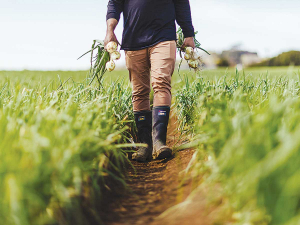Damien O’Connor: NZ united on global trade
When it comes to international trade, politicians from all sides of the aisle are united, says Labour's trade spokesman Damien O'Connor.
 The new government and industry strategy aims to grow the value of New Zealand’s horticultural production to $12 billion by 2035.
The new government and industry strategy aims to grow the value of New Zealand’s horticultural production to $12 billion by 2035.
A newly launched government and industry strategy aims to grow the value of New Zealand’s horticultural production to $12 billion by 2035.
“We’re focused on long-term strategies that build on the yearon- year record revenue earned by our farmers and growers,” claims Agriculture Minister Damien O’Connor.
Last year, NZ’s primary sector export revenue was $53 billion, with horticulture contributing $6.7 billion. In 2023, horticulture exports are expected to hit a record $7.1 billion.
“The new Horticulture - Growing Together 2035 - Aotearoa Horticulture Action Plan Strategy set outs the pathway to achieve what is an ambitious and achievable goal,” O’Connor said at the reports launch.
“Consumers here and around the world continue to demand high quality and nutritious fresh fruit and vegetables to boost their wellbeing. Food security is a growing issue globally and we want to ensure New Zealanders have access to affordable food.”
O’Connor says the Growing Together 2035 Strategy’s vision is that New Zealand is synonymous with worldleading healthy produce, which is grown with care for people and place, and is enjoyed by consumers around the world.
“New Zealand has worked hard to build an excellent brand for quality. We’re fortunate to have one of the best climates and some of the most fertile soil in the world providing the right foundations to grow world-class produce.”
The Strategy focuses on five outcomes:
- Grow sustainably
- Optimise value
- Māori are strong in horticulture
- Action underpinned by science and knowledge
- Nurture people.
Horticulture New Zealand chief executive Nadine Tunley said the plan deliberately focuses on outcomes and actions across the value chain where partners can collaborate to generate the most benefits.
“Its outcomes are supported by a series of actions that will work together to grow the overall sustainability and value of NZ’s horticulture sector,” she explained.
Tunley added the actions range from identifying energy-intensive areas of the horticulture value chain and supporting conversion to systems that reduce greenhouse gas emissions; to improving crop management and protection, developing pathways to increase Māori participation, increasing capability; and better understanding consumer needs and channels to market.
She says during this year, the action plan will be driven forward by a dedicated programme manager who will find opportunities to existing work and bring partners together to develop new projects.
O’Connor says the Growing Together 2035 Strategy aligns with the Government and sector roadmap, Fit for a Better World and the National Policy Statement for Highly Productive Land, and builds on the sector’s Horticulture Post-Covid Recovery Strategy.
According to the latest Federated Farmers banking survey, farmers are more satisfied with their bank and less under pressure, however, the sector is well short of confidence levels seen last decade.
Farmer confidence has taken a slight dip according to the final Rabobank rural confidence survey for the year.
Former Agriculture Minister and Otaki farmer Nathan Guy has been appointed New Zealand’s Special Agricultural Trade Envoy (SATE).
Alliance Group has commissioned a new heat pump system at its Mataura processing plant in Southland.
Fonterra has slashed another 50c off its milk price forecast as global milk flows shows no sign of easing.
Meat processors are hopeful that the additional 15% tariff on lamb exports to the US will also come off.